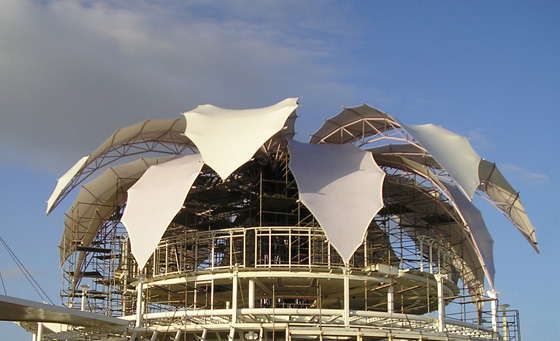communist party of Venezuela and spreading his ideas in different political forums. He became a quite controversial man which played a role in the way the audience judged his works. He played a strong role in societal issues and built safe house and routes for the armed forces of nation liberation. He had a heavy alignment with pride for his country and also making sure it’s people were protected in different facets of the government.
Fruto Vivas incorporated many of his beliefs in
his work but the two key themes of this work where nature and technology and
their relationship with each other. Vivas created this theme of nature through creating
an 18 petal flower that opens up in the light and closes during the day.
Venezuela has a huge amount of biodiversity, which has made it popular. He incorporated
a light weight material to ensure movement of the petals to highlight his theme
of nature and make the pavilion more realistic. He then used an intricate lighting
system and sleek metal to give the flower a very techno looks. This is a stark contrast
with its representation of nature. It served to represent innovation on the
technological front for
Venezuela. He meshed these to together to show how one
does not have to negate the other. He wanted to stress the importance of the
coexistence of technology with nature because he felt that beauty in nature was
important to acknowledge and appreciate. He did not want that to get lost in
the growth of technology. By incorporating advanced technology with the nation
flower, he created a space that many enjoy sitting under while simultaneously conveying
the message of the importance of both and the beauty in their coexistence.
The beauty behind this piece exists in it’s
theme of the harmony that must exist between nature and technology. Fruto Vivas
addressed an issue that is so relevant to us nowadays. This idea that with the
growth of technology, the appreciation for organic beauty has become antiquated
is false and Fruto Vivas shows how the two can exist. Nature in inherently beautiful
but the things we have innovatively discovered and created through technology
are equally as fascinating. Vivas constructed that pavilion with precision and
articulation, focusing on the materials and movement. The combination of the realness
of the flower and the patriotism within the piece made it significant. I also think
that art that
everyone can enjoy is beautify. Opening up a piece for
interpretation is generous to the audience. I also find art that is not only
visually pleasing but functional as well to be beautiful. The beauty exists in
the use of the piece. It is existing not only to please the eye but also as a
space for people to create memories which contributes the message of the piece.
Art that betters everyone who encounters it is “good” art. It should move its audience
in some way or provoke thought. This piece challenges it's spectators and users
to find a balance in nature and technology.

I also did this piece of architecture for my Spanish presentation! I stumbled upon this piece unknowingly and fell in love with it. I think that it is actually a very unique piece and quite interesting. Did you know that the "petals" of the building can open and close depending on the weather?
ReplyDeleteI love how versatile this piece is and the contrast it provides in the Venezuelan community. Great choice!
I did not know about this building. Thanks for sharing!
ReplyDeleteI did not know about this building. Thanks for sharing!
ReplyDeleteThank you so much this helped with my spanish hw.
ReplyDelete